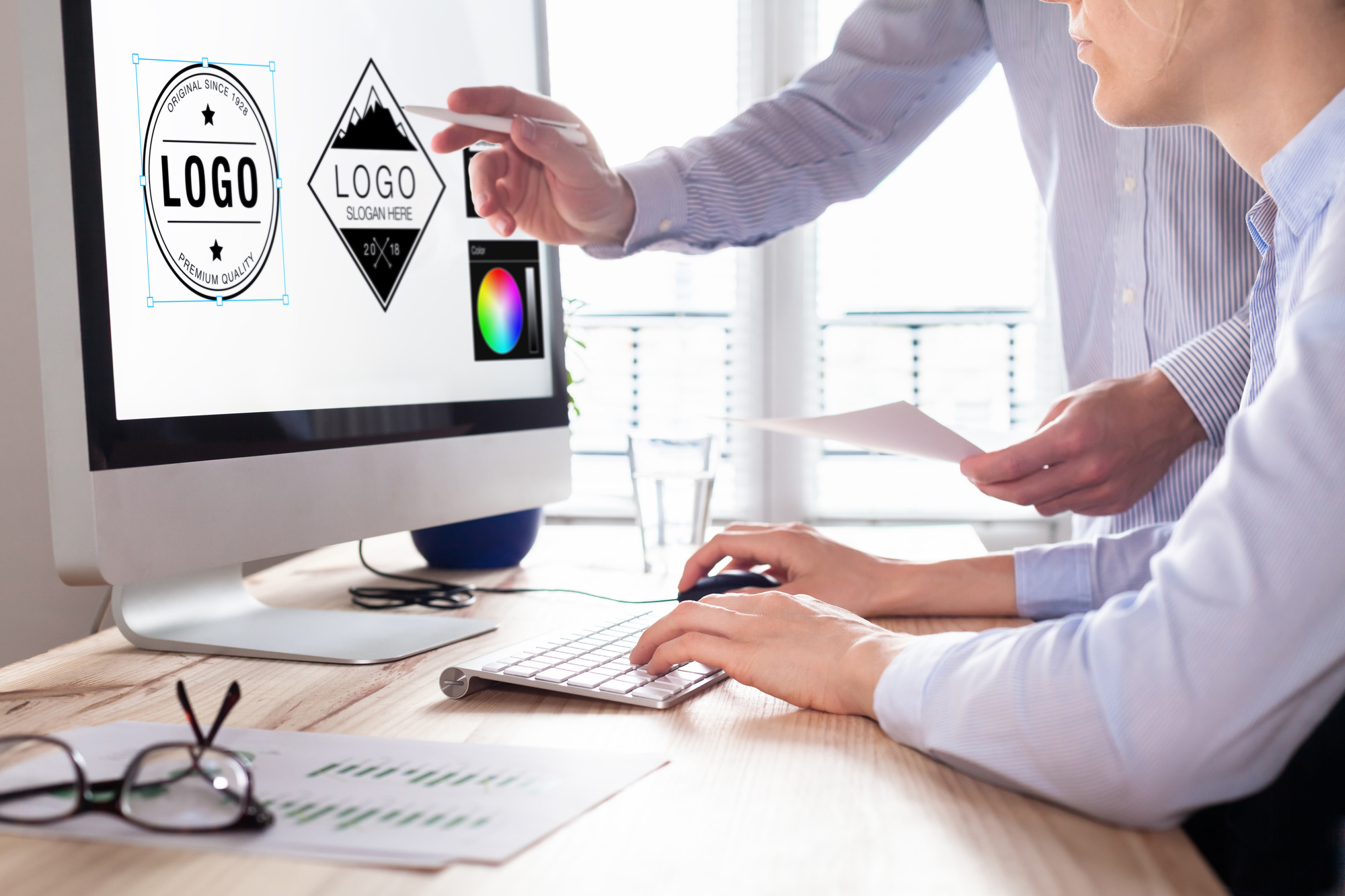5 Logos For Your Weight Loss Company to Make You Stand Out
Posted on December 19, 2018 by Logo Design Tips and Tricks

The weight loss market in the US is now worth a staggering $66 billion.
It should, therefore, come as no surprise that more people than ever before are starting weight loss companies of their own, in the race to grab a slice of this rapidly-growing market.
With obesity rates on the rise, consumers are looking for effective and high-value options to curb weight gain. While the product is the most important part, this alone won’t translate into sales.
Marketing is everything, meaning that you’ll need to be able to reach out to customers as a brand before they’ll choose you. Your logo is a key part of this.
If you’re looking for a weight loss logo that’ll attract the customers you need, look no further. Take some inspiration from these five logo ideas for your weight loss company.
1. The Original Weight Loss Logo: Weight Watchers
Weight Watchers is one of the most successful weight loss programs in human history, with millions of followers.
Part of their success is their phenomenal branding finesse. This is what has turned them into a globally recognized provider of weight loss solutions.
Their recently redesigned logo gives them a sleek, positive feel that any other company should aspire to.
2. Empower Logo
Empower provides medical weight loss solutions, not too dissimilar to the hugely popular medicinal weight loss drops that have taken off in recent years.
Their logo captures the “all natural” element of their brand while letting the customer know that choosing them is a choice for good health.
The simple color scheme is definitely something your weight loss company should bear in mind.
3. Nike Logo
Not a weight loss company per se, but the beautiful simplicity of the Nike logo embodies what you should be trying to capture.
The simple “check” image instantly resonates with audiences, which any successful weight loss company should do. The symbol also implies motivation and success, which is what weight loss is all about.
4. I
What is it about this logo which makes it so successful? Designed by artist Milton Glaser in 1977 as an attempt to revive the ailing city of New York’s fortunes, this counts as one of the most successful branding initiatives in history.
The simple heart emoticon is an effective way to get customers to connect emotionally with your brand, which is crucial for loyalty and retention.
This is emotive branding at its best, perfect for any company promising a journey toward health and happiness.
5. Target Logo
Weight loss success means weight loss motivation.
The simple bulls-eye motif here can be used to great effect for a weight loss company that’s all about goals and ambition. Weight loss is an achievement, one that takes hard work and dedication.
Any brand-savvy weight loss company should take inspiration from this kind of branding. It delivers on that aspirational message with minimal effort or detail.
Get Creating!
Now that you have the inspiration, it’s time to create. Make sure to register with us today if you want to create the perfect logo for your weight loss company.
Special Invitations: How to Make Your Christening Cards Stand Out
Posted on December 17, 2018 by Logo Design Tips and Tricks

Every parent wants his baby’s Christening to be special. After all, the most important people in your life are going to be there and celebrate your beloved child. From sending custom invitations to planning a memorable ceremony, there are plenty of ways to show how much you appreciate their presence.
Consider sending out personalized Christening cards. Why choose cookie-cutter designs when you can add a touch of style and personality? Don’t worry – this doesn’t mean you have to spend a fortune.
Simple things, such as creating your own design, writing a heart touching message, or including a poem you love, can make your Christening cards stand out. Check out these tips for inspiration:
Choose a Visual Theme
When you’re browse Christening cards online, look beyond those simple, bland designs that are all over the place.
Select one with beautiful images that reflect the importance of this special event. Better yet, consider having your baby’s photo printed on the card.
Nowadays, there are plenty of graphic designers who can create beautiful Christening cards on demand. Contact a few and let them know what you need.
Another option is to purchase custom Christening cards over the Internet.
Some vendors offer stunning templates that can be personalized with your favorite colors and photos. You can even choose the type of paper, fonts, shape, and mailing service to make your cards truly unique.
Create Your Own Baby Christening Cards
Why not make your own Christening cards? Use a software program like Adobe, Microsoft Office, or Photoshop. Simply choose a template, add the desired text, and upload a beautiful photo.
If there are any employees or business partners you’d like to invite to this event, consider adding your company’s logo on the card. While it’s true that we’re talking about a family event, your business is a part of you.
Once the cards are ready, print them on quality paper and mail them to your guests. You could also send out a digital version to make sure everyone receives your cards well in advance.
Include a Meaningful Message
Honor this special day with a meaningful message that your guests will cherish. Your Christening cards may include a short poem, greeting, or bible verse along with the name an location of the church, time and date, and other details.
Your message may be either formal or informal. It all comes down to your preferences. Consider the venue where your event will be held and who will attend.
Make Your Christening Cards Unique
There are plenty of other ideas to make your Christening cards stand out. For example, you can include an RSVP and use beautiful finishes, such as letterpress, embossing, or foil.
Get creative and play with the card’s shape and size. Remember, there are no set rules when it comes to Christening invitations. Make them as simple or as sophisticated as you want.
However, try not to squeeze too much onto the card. Keep it simple yet stylish. Choose your words wisely and select a photo or image that’s suitable for this special event and reflects your personality.
For other design tips and creative ideas, check out the rest of our blog. We’ll show you how to choose from the different types of fonts, how to match font and image on your design, and much more!
7 Inspiring Fashion Logo Ideas That Will Transform Your Brand
Posted on December 10, 2018 by Logo Design Tips and Tricks

Without a doubt, fashion is very much an emotional purchase.
While clothing is a necessity, people shop with fashion brands that they believe in and are inspired by. Before even experiencing the aesthetic, material, and design of your clothing, buyers need to be inspired by your fashion logo.
A good fashion designer logo stands the test of time and creates an emotional response that makes buyers want to be apart of what you offer. If you own a fashion brand, you are sitting on the shoulders of giants in the industry who have paved the way.
While planning out your logo, be sure that you take some inspiration from fashion labels that have come before you.
Consider these iconic and inspiration logos as you look to create your own.
1. Dormouse
The fashion logo matters just as much for kids’ clothing as it is adults’.
Dormouse is a kids brand that conveys what they are all about with the playful mouse logo. Even today, you probably get an emotional response when you see the Disney mouse or the Chuck E. Cheese mascot.
There’s just something about a playful mouse with big dreams and lots of fun that captures the imagination of kids. Dormouse’s logo says a lot with its logo without having to say anything at all.
Kids’ fashion brands are starting to take note. If you’re interested in browsing some inspired kidswear logos for ideas, you can see more here.
2. Coach
Your carriage awaits.
You can practically smell the leather and feel the quality material on your body when you see that horse and carriage logo. It denotes sophistication that you just don’t get with every brand.
Knowing your own brand inside and out helps you stand out from the competition.
Since Coach prides itself on being a cut above, it clearly starts with the logo.
3. Supreme
One word.
That’s all it takes to convey what your brand is all about sometimes. It features a deep red so that it draws your attention, and has the right amount of boldness to represent the New York skateboard scene from which the brand was birthed.
It even is reminiscent of a graffiti tag, which gets extra points for a popular streetwear brand.
4. Ray Ban
The font for this signature is the icing on the cake on a set of frames that are always built with craftsmanship.
When you see a pair of Ray Bans, you can already tell that they’re stylish and solidly made. Seeing the tiny signature on the lens or the handle is like an artist signing their masterpiece.
5. Chanel
No matter what social setting you’re in, those interlocking C’s will turn heads.
The Chanel brand denotes class and style and is a cut above the rest. The bold simplicity of the Chanel logo sets the tone.
It’s bold enough to make a statement, though not so gaudy that it takes away from the design of the bags themselves.
6. Tommy Hilfiger
The red, white and blue of Hilfiger is one of the most iconic fashion logos of all time.
It’s stylish and universal, crossing demographics and tastes. With a logo like this, the buyer is proud to wear the clothing.
7. Bushwhack
Just hanging out and hitting the waves.
The Bushwhack logo features an old school van reminiscent of the heyday of surfing and the hippie era. Whether you grew up during that time or are a surfer inheriting the history, it creates a response and makes you proud to wear it.
Research the Best Fashion Logo Ideas
So there you have it.
Start with these fashion logo ideas and you should have a great foundation to work with. Remember that it’s always about creating a personal connection with people.
Find out how you can create the artwork that accomplishes that.
Check out our Online Logo Maker and don’t hesitate to contact us if you have questions.
5 Steps to Successful Marketing Company Logos
Posted on December 10, 2018 by Logo Design Tips and Tricks

According to Forbes, 50% of consumers suggest their first use of a product or service is when they decide if they are going to be loyal to a company.
As brand image continues to be one of the important factors that play into whether a potential customer will give your company a chance, it is more important than ever to get your marketing company logos right.
A poorly designed logo could damage your company’s brand more than any other graphics component. The reason it could damage your brand so deeply is that you use it on every marketing piece you create.
Your marketing logo design is like your handshake before you can shake hands.
Continue reading this article to learn the five steps to take to great a marketing agency logo that will work for and not against you.
Marketing Company Logos – Your Handshake Before the Handshake
When you are working with your designers, developers and graphic artists, you need to make sure everyone is working together. Your logo should be on point with your brand, and all of your other materials should flow well with it. Failing to coordinate your teams could result in products that are great separately but not impressive when put together.
Now that you have the overall picture in mind let’s focus on your marketing logo design and the tips that will help you make a design that compliments your company.
1. Think Long-term
When you are designing your logo, you need to think long-term. Your logo is likely to evolve as time progresses. Create a logo that is easy to upgrade and freshen up as your company grows.
If you on growing a large company, you don’t want to create a logo that creates the perception you are a small business. While there is nothing wrong with a small business, you need to let your potential customers know what you are all about.
While you could rebrand and change your logo, this process will undo all of the branding work you did already.
2. What Type of Local Do You Want?
When you talk to your designer, they usually will ask you what type of logo you want. The types of logos are typography, illustrative, and abstract. Here are some examples of these logo types:
- Typography logo – A logo that is created from text. These logos can use different fonts and coloring to show your brand’s image and personality.
- Illustrative logo – These are logos that are imaged based. They usually have an image that shows what type of work your company does.
- Abstract logo – These logos use images but aren’t always images you would expect to link to your company. There may be some background or value you are trying to convey to the viewer through your logo.
You don’t have to choose one type of logo; you can create a combination of the three to find your perfect look. While you don’t need a complicated logo, you don’t want it to be too simple.
3. Color Palette
If your brand doesn’t already have a color palette, this is the perfect time to create it. Your brand’s color palette will be used in all situations from logos, website, promotional materials, team clothing and more.
As you are choosing colors, don’t simply choose colors off of what you like or what makes you feel good. There is a psychology behind colors and paying attention to what the colors do and how they make your potential clients act is important.
Depending on the country you are located, colors mean different things to different people. If you are an international company, make sure you are appealing to people globally and not only those that are in your country.
Ask your designer about a color wheel so you can get ideas for the colors you want to use for your company.
4. Choosing a Font
When you choose a font, you want to make sure it is easy to read and attractive. Like the logo of this company, you want to make sure people will remember your logo and link you to what you do when they see it.
There are so many different fonts to choose from as you’re looking through the options. You want to think of your logo as a whole and not forget about any imagery that will need to fit around the font you choose.
Fonts have different personalities. Some fonts are playful, and some fonts are serious. Choose the personality of the font you want to use to help you make your decision.
5. Don’t Be Boring
When you create your logo, you don’t want it to look like every other logo in your industry. Even if your industry isn’t a creative industry, you need to be creative or give your logo designer the freedom to design a logo that is out of the box.
Doing proper research before creating your logo can help you avoid the embarrassment of creating a logo that is too close to a competitor you hadn’t paid attention to. You won’t be helping your brand if people confuse you with your competition.
You can always use your competitor’s logos to get inspired for your own but never make a knock-off logo. Even if a brand is bigger and more successful than your brand, that doesn’t mean their style of logo is the right one for you.
As you look at the other company’s logos, see what components of the logos you like. You might like a certain shape, flow or color they used. You can put these elements into your own design but with a new flare that has your brand’s identity at the forefront.
Building Your Brand
Now that you have ideas for marketing company logos that will allow you to start working toward the perfect image for your brand, you are on the right track. Don’t stop making progress in building your brand.
Continue learning by reading our article on how to stand out from the competition today.








